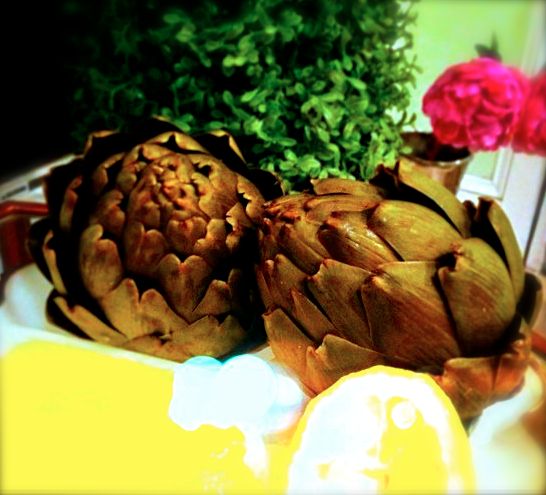
A couple of years ago, I went through this weird phase where I ate steamed artichokes practically every single day. Basically, what happened was that I discovered that they are less vegetables than they are butter delivery systems, and boom: obsessed.
Anyway, I haven’t had one for ages and ages, and then last night, all of a sudden, I decided that artichokes must be steamed. Lemon butter must be made.
It was awesome (albeit not the loveliest thing in the world to photograph post-steaming, but what can you do?).
Look for one that’s heavy for its size and has tightly-packed leaves, with no discoloration. While you can technically find them all year round (especially in California), they’re best in the spring (March-May).
1. First, wash them and cut off all but about about 1/2″ of the stem. (Some people also cut off the sharp-ish tops, but I don’t have the patience for that. Just, you know, don’t eat the bits that hurt. Obviously.)
2. Place the artichokes stem-side-up in about 3/4″ of boiling water (use a vegetable steamer if you happen to have one), cover (leaving the top slightly at an angle so some steam can escape), and steam on low heat for 40 minutes or so, adding a little more hot water if the level gets too low. If a fork can easily be inserted into the base of the artichoke, it’s ready to eat.
I’m serious: do not serve an artichoke without lemon butter, because it will be a mistake. To make lemon butter, just reduce the juice of 1 lemon in a small pot for a couple of minutes, and then add 3/4 of a stick of butter cut into smallish pieces. Let the butter melt gently, and then allow the lemon butter to cool a bit so it thickens up before serving.
Or, you know, melt a bunch of butter in the microwave and squirt in some lemon juice straight from a bottle. Whatever.
For those of you who’ve never eaten an artichoke, I get it: the things look intimidating. But all you do is peel off the leaves one at a time, dip the tender ends in butter, and then use your teeth to work off the delicious part (the leaves get increasingly tender as you head towards the center; the very outermost ones may not be edible at all).
Once you hit the hairy part (ssh, I know, but don’t worry: it’s worth dealing with the creepy factor to get to what’s underneath) just use a spoon to scrape it off and what you’re left with is the heart, which is so wonderful that I have been known to get all obsessive and hoarder-y about them.
Enjoy.








